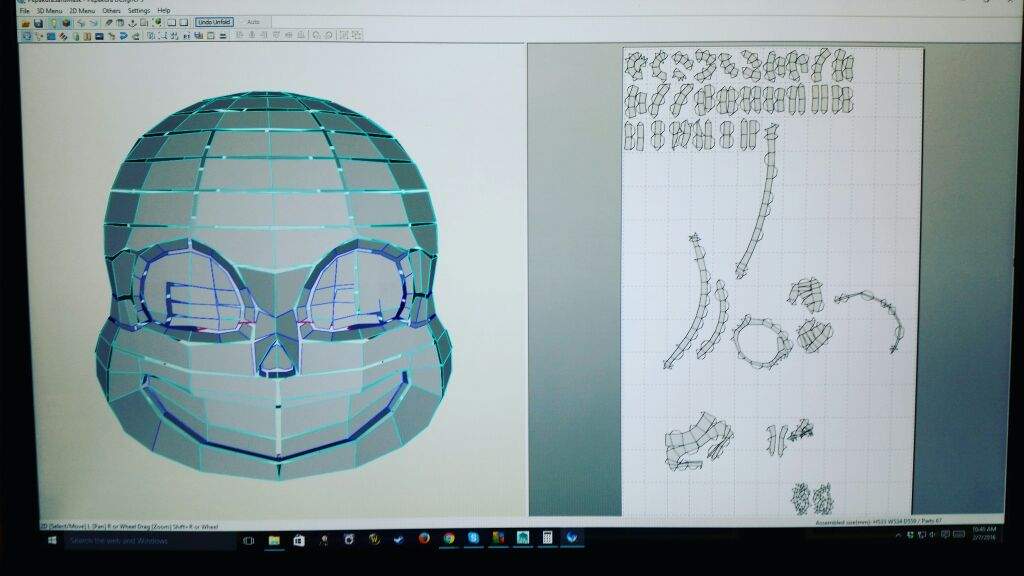

By scrolling the scroll wheel, you can zoom in and out. Now you have a larger screen area to move these pieces in.

To aid this, click "Configuration" and click "Show Only 2DPatternWindow". Aren't you glad you held back from moving pieces the first time? So to finish up, you'll need to get all the pieces into their page squares. Highlight that current scale and replace it with the one you just calculated. Take that last number(26.461045), go to 2DPatternWindow, then click "scale up/down development by specifying value.". Then multiply that number by the scale of the current piece you are working on (Right Bicep's scale is 30.342, so 30.342x0.872093=26.461045). Then add 3 inches to that measurement.(for me, 75 inches). Measure your height in inches (I'm 6 foot even, so that's 72 inches). I learned the following formula from the forums. To make the completed Pepakura piece scaled to fit your body type, you'll need to do a little math. While you might be compelled to re-arrange them, it is not that time yet. Hit OK and notice that those pieces on the right side of the screen are now jumbled up out of their page boundaries. Select "Letter" from the Size drop-down menu, and adjust both margins to 5 mm. In this example, I will be using Letter size(8.5x11 inches) paper. Click on "Configuration" in the toolbar, then click on "Print and Paper Configuration". if you're using A4 size paper, then skip to the next step. Now you'll need to specify your paper size.

this will make the printed pieces while as opposed to gray, saving you ink. pdo file, you'll want to click on the "BothWindows" tab and uncheck "use materials for faces". I'll get to that in the next step so for now let's focus on getting this to paper. It takes 3D models, and through user-manipulation, creates 2D pieces that can be printed on paper, then cut apart, folded, and glued together to create 3D pieces. What you see is the magic of Pepakura Designer 2. On the right you'll notice a grid with odd-looking pieces in each cell. On the left, you have a 3D model of what you will be making. Open up Right-Bicep.pdo and you will see two sub-windows. For this step I'll be using the Right-Bicep file. Point the file browser to the folder you stashed those. So open it up, go to file, and click Open. pdo files, it's time to open Pepakura Designer. Ok, now that you've installed Pepakura Designer and downloaded your. make sure you'll never need em for food again) Facemask or respirator for working with resin/fiberglass/sanding Tape and super glue press cardstock(not pictured) "Medium Grit" Sandpaper Primer for sanding aid(not pictured) Some type of rubber gloves(disposables) Container for mixed resin(i use the lid from the quart can, and line it with aluminum foil so I can use it again) Measuring paraphernalia(teaspoons, tablespoons, etc. Tools: Dremel with cutting disc and sanding bit Hot-glue gun with plenty of sticks 9 quarts of Bondo resin*(two gallons and a quart=70 bucks) 5 packs of Bondo fiberglass cloth(25 dollars) Bondo Body Filler(not pictured) about 200 sheets of 110 lb. I'll get to other detail and accent pieces like the gold visor and such later in this instructable. Note that this list includes only what you need for making the pieces. So I'm going to guesstimate on total quantity here(marked with * for unsure-ity). That was enough to resin-coat all the pieces, and fiberglass the right arm, helmet, chest, crotch, and right leg. So far, I've used 5 quarts of resin, and 3 packs of fiberglass.

The one key part of this suit is Fiberglass and resin. I'll go over that in the next section but keep this in mind. The ground for this suit is printed paper, cut, folded and glued to produce 3D pieces. Good to know, cause without one and a working printer you will go nowhere with this. Obviously, if you're reading this instructable, you have a PC.


 0 kommentar(er)
0 kommentar(er)
